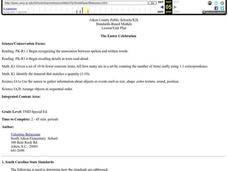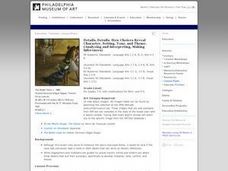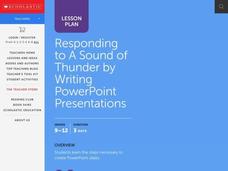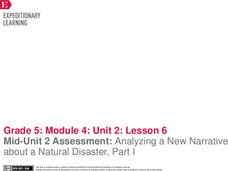Curated OER
Legends of the Navajo People
Second graders are read a story in which they begin to examine Native American legends. Using different legends, they discuss how they affected the future people of native peoples. They write a short story on the information they gathered.
Curated OER
Design A Community Program
Students read a short story and state the main idea. Using their community as an example, they brainstorm a list of problems they notice. They use the internet to investigate community projects and write a proposal for a project in...
Curated OER
The Easter Celebration
Students read a short story about Easter. They recognize and point to pictures of the key words (egg, chicken, rabbit, basket, flower). They make an Easter basket and count how many chickens can fit inside. They also practice identifying...
Curated OER
Onomatopoeia Poems
Students write onomatopoeia poems. In this creative writing instructional activity, students listen to a picture book that introduces the concept of onomatopoeia. Students create their own list of words and write a short poem using...
Curated OER
Strange Sports
Sixth graders compare and contrast strange sports. In this comparing lesson, 6th graders read an article about strange sports then compare and contrast these sports to ones they are familiar with. This lesson includes an assessment,...
Curated OER
Understanding Character
Students are introduced to literary elements and definitions in the worksheet Understanding Character but reading through each of the elements and definitions aloud. They read the story, "La Bamba" and identify examples of the literary...
Curated OER
Comparing Fiction and Nonfiction
Fifth graders compare and contrast an informational article with a fictional story. They read the story "The Contest" as a class, and discuss the different types of literature genres. Next, they complete a vocabulary worksheet and a...
Curated OER
A Picture Is Worth a Thousand Words
Students, after reading the book, "Esperanza Rising," create a virtual display by combining different story elements into a visual representation. They choose the setting and characters of a scene that will act as a springboard of ideas...
Curated OER
Details, Details: How Choices Reveal Character, Setting, Tone, and Theme. (Analyzing and Interpreting, Making Inferences)
Students respond to works of art. In this art interpretation instructional activity, students examine images of art while using concepts they learned as they read literary pieces. They detail the setting, characters, and the mood and...
Curated OER
Diary of Anne Frank: Act 1 Scene 1 & 2
Eighth graders read act 1 scenes 1 & 2 of the play Diary of Anne Frank. In this Diary of Anne Frank lesson plan, 8th graders discuss how the setting of the play affects the mood of the story and answer short answer questions.
Curated OER
Symbolism
Young scholars engage in a lesson about symbolism while reviewing the work of Edgar Allen Poe. They review the definition of symbolism and use it to list the symbols in his work. They write a journal about how the author uses many...
National Endowment for the Humanities
"Old Southwest" Humorists and George Washington Harris
Young scholars discover the work of George Washington Harris and his influence on American humor. For this George Washington Harris lesson, discuss cultural differences in the United States and read Sut Lovongwood stories by George...
Curated OER
Responding to A Sound of Thunder by Writing PowerPoint Presentations
Students, after reading "A Sound of Thunder," create a PowerPoint presentation about time travel. They study and utilize a graphic organizer to assist them in preparing to deliver an oral presentation next and finally they print their...
Curated OER
Exploring War Themes in Art and Poetry
What is war? Students discuss the ethical dilemma of war by viewing Picasso's painting entitled "Guernica" and write down everything they see in the painting. Then they choose one emotion that best summarizes their emotional response to...
Curated OER
Science: Bees: An Interdisciplinary Approach
Students investigate the world of bees and describe their characteristics. by identifying the bees' parts, they demonstrate how these parts function. In the lab, students dissect bees and view the various parts under microscopes. ...
Curated OER
"In a Grove" and "Rashomon" by Akutagawa
Students read and analyze the short stories, "In a Grove," and "Rashomon," by Akutagawa. They discuss the samurai warrior culture, watch a short video, take a quiz, participate in whole-group discussions, identify similes and metaphors,...
Curated OER
Rain Forests
Students investigate the animals and plants of the rainforests. They define rainforest, watch and discuss a National Geographic video, and write a short story.
Scholastic
Identifying Types of Irony Using "The Gift of the Magi"
O. Henry's "The Gift of the Magi" is the classic example of irony in literature. Teach young writers about the ways irony can engage their readers with an activity in which they write scripts using dramatic irony, situational irony, and...
Houghton Mifflin Harcourt
Problem Solvers: Challenge Activities (Theme 4)
Creative activities help bring literature alive. The first of a set of lessons designed to accompany selections from Theme 4: Problem Solvers uses activities such as skits, responses to music, and social studies projects. These...
Schools United to Provide Enhanced Resources Network
AP English Project: Journal of Literary Terms and Devices
To prepare for the AP English exams, individuals are asked to create a notebook of literary terms and devices. The terms must be defined, accompanied by representative artwork, and illustrated by an example drawn for a named source. A...
EngageNY
Mid-Unit 2 Assessment: Analyzing a New Narrative about a Natural Disaster, Part I
Scholars complete a mid-unit assessment by analyzing a narrative text, In the Middle of the Storm. Learners determine the gist of the text, identify synonyms, make inferences, and answer text-dependent questions to demonstrate...
National Endowment for the Humanities
Kate Chopin's The Awakening: Local Color in the Late 19th Century
Kate Chopin's The Awakening introduces readers not only to the lush Louisiana setting of Grand isle but also to the nuances of Creole culture. the second lesson in a three-part series examines how Chopin's use of literary realism and...
Cornell University
Fibers, Dyes, and the Environment
Nanofibers can be made through electrospinning or force spinning in order to reduce the negative impact on the environment. Pupils study the role of fibers and dye on the environment through a series of five hands-on activities. Then,...
Curated OER
Locating Words
Students locate various basic sight words in an article or a story. They read the word list/worksheet, and independently locate and circle each word from the list on the article.























